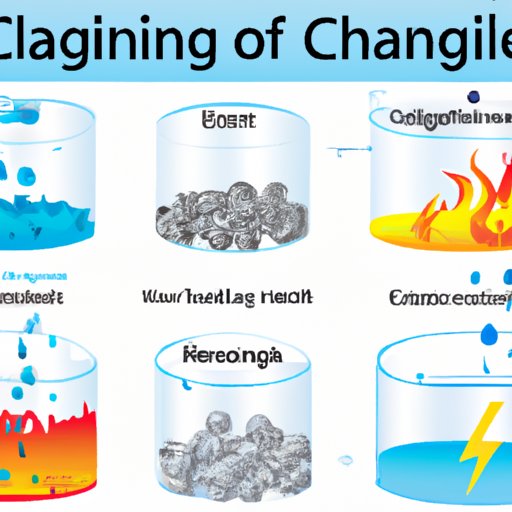
Introduction
Matter is something that surrounds us and takes various forms, whether it is in solid, liquid, or gaseous state. One of the fundamental questions that scientists asked is how matter changes over time and why. There are two main types of changes that matter can undergo: chemical and physical. In this article, we will explore these two types of change, their nature, properties, and effects, as well as their historical evolution, practical applications, limitations, and implications.
Comparative Approach
Chemical change and physical change are distinct and different phenomena that arise from different causes and have different consequences. Chemical change involves a rearrangement of the atoms and molecules of a substance, which leads to the formation of new substances with different properties. Physical change, on the other hand, does not involve the alteration of the chemical nature of the substance but instead affects its physical properties such as size, shape, state, and density.
Certain signs indicate that a chemical change has taken place, such as a change in color, temperature, smell, or the production of gas, light, or sound. Chemical reactions are irreversible, meaning once the reaction has occurred, the substances formed cannot be converted back into their original constituents. Physical changes, on the other hand, can be reversed by simple physical manipulations such as cooling, heating, crushing, or bending the material.
To illustrate the differences, let’s consider an example: the burning of paper. When paper is burned, it undergoes a chemical change, and new substances such as carbon dioxide and water vapor are produced. The ash that is left behind has different properties than the paper. In contrast, if you tear paper into small pieces, you have not changed the composition of the paper, only its shape and size.
Descriptive Approach
Chemical change is a process that occurs when two or more substances interact with each other and rearrange their atoms and molecules to form new substances with different properties. In this process, the chemical bonds between atoms are broken, and new bonds are formed. The chemical formulas of the reactants and the products are different, indicating a chemical change has occurred.
Physical change, on the other hand, is a process that affects the physical properties of the substance, such as its size, shape, and state. It does not involve the alteration of the chemical nature of the substance. Common examples of physical change include melting, freezing, boiling, evaporation, and condensation.
Several factors affect the rate and extent of chemical and physical change. These factors include temperature, pressure, concentration, surface area, catalysts, and inhibitors. In general, chemical reactions usually occur faster at higher temperatures, higher concentrations, and when the reactants have a larger surface area. Physical changes, such as melting and boiling, also depend on temperature and pressure, but they do not involve chemical reactions.
Historical Approach
The concepts of chemical and physical change emerged in the seventeenth and eighteenth centuries when scientists began to explore the nature of matter and its transformations. Some of the major discoveries and theories in the evolution of chemical and physical change include:
- Antoine Lavoisier’s theory of combustion and his law of conservation of mass (1789)
- Joseph Black’s discovery of latent heat and his work on specific heat (1761)
- John Dalton’s concept of atoms and his law of multiple proportions (1803)
- Jöns Jacob Berzelius’s development of the modern system of chemical symbols (1813-16)
These and other findings provided the foundation for modern chemistry and helped scientists understand the fundamental principles of matter and its transformations. Over time, chemical and physical change theories evolved and refined as new discoveries were made, leading to the emergence of quantum mechanics, thermodynamics, and other fields that delve deeper into the nature of matter.
Applied Approach
Chemical and physical change concepts have found practical applications in various fields, such as industry, environmental systems, and biological systems. Chemical reactions are the basis for many industrial processes, such as chemical synthesis, combustion, corrosion, electroplating, and metallurgy. Physical changes are also important in many industrial applications, such as welding, cutting, molding, and shaping of materials.
The impact of chemical and physical changes is evident in environmental systems, with examples including acid rain, greenhouse gases, and the ozone hole. Understanding the chemical and physical properties of pollutants and their transformations is crucial in evaluating and mitigating their effects on the environment.
Biological systems depend on chemical reactions and physical processes to function, such as cellular respiration, photosynthesis, and digestion. Understanding these processes and how they affect living organisms is essential in developing therapies and treatments for various diseases and conditions.
Critical Approach
While chemical and physical change concepts have proven useful in explaining many phenomena, they may not be sufficient to account for every aspect of the natural world. Alternative frameworks, such as those based on systems theory, complexity theory, and information theory, offer new insights into the nature of matter and its transformations. These frameworks focus on the interconnectedness and interdependence of various components and processes in a system and how they give rise to emergent properties and behaviors.
Moreover, there are underlying assumptions and biases in chemical and physical change concepts that cannot be ignored. For example, these concepts assume that the natural world is deterministic, predictable, and reductionistic, meaning that complex systems can be understood by breaking them down into simpler components and interactions. However, recent research has shown that the natural world also exhibits indeterminacy, unpredictability, and emergence, which challenges the conventional wisdom of chemical and physical change.
Conclusion
Chemical and physical change are fundamental concepts that underlie many natural phenomena. They are distinct phenomena that arise from different causes and have different consequences. While chemical and physical change concepts have proven useful in many practical applications, there are alternative frameworks and limitations that must be considered. As you explore this topic further, keep in mind the complexity and interconnectedness of the natural world and the need for continued exploration and refinement of our theoretical models.





